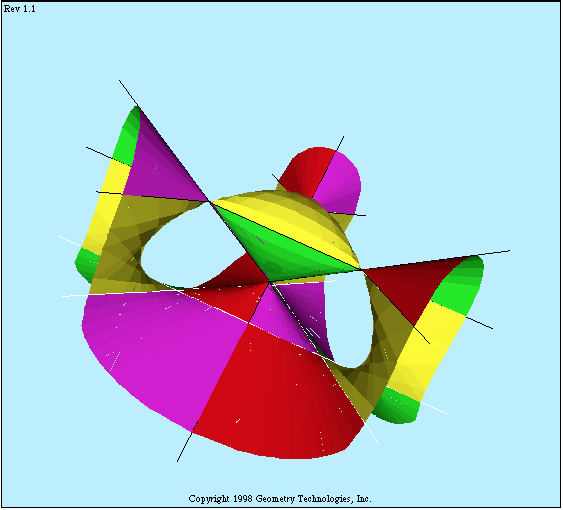|
Static views:
JGV Links:
Other:
| |
Projective duality:
The figure shows part of the Cayley surface. It is a surface of degree 3,
with 4 singular points. These singular points are often called
nodes.
There are 9 lines on the Cayley surface. Six of them join pairs
of nodes.
Thus, we can view the nodes as vertices of a tetrahedron, and these six
lines are the edges of the tetrahedron. The other three lines lie in the
trigangent plane, which will be discussed below.
The Cayley surface is the dual variety of the Steiner surface. This means that
the points of the Cayley surface correspond bijectively to the tangent planes
of the Steiner surface (except that the correspondence
is not bijective along finitely many subvarieties).
Here are some specific features of this correspondence:
- Each of the 6 lines that joins a pair of nodes on the Cayley surface is
the locus of tangency of a single plane. Therefore each of these lines
corresponds to a single point on the Steiner surface -- actually one
of the pinch points.
- Each of the 4 plane conics on the Steiner surface is the locus of tangency
of a single plane. Therefore, each of the plane conics on the Steiner
surface corresponds to a single point on the Cayley surface -- actually
one of the nodes(!!). Click here to see the a drawing of the portion of the Steiner surface
around the triple point and these 4 plane conics.
- At the triple point of the Steiner surface there are three distinct
tangent planes. This imlies the existence of a plane which is tangent
to the Cayley surface at three distinct points.
- Sevín Recillas, who got me interested in the Cayley surface,
called this plane the tritangent plane.
- The intersection of the tritangent plane with the Cayley surface is
the union of 3 lines which intersect pairwise in 3 distinct points.
These lines correspond in a natural way to the 3 lines on the
Steiner surface. {The lines on the
Steiner surface go through the triple
point.}
| |
